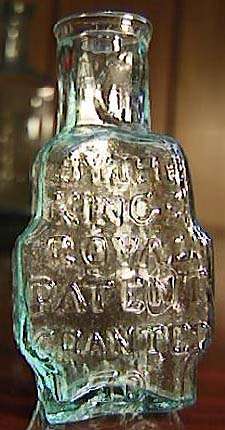

Following info was graciously contributed by
Mitch Brown, an
expert on Turlington bottles and co-author of an
upcoming book
on the subject.
-Historical Background-
Robert Turlington, a merchant, was granted a patent by King George II in
London, England, in 1744 for his invention of a legendary "specifick [sic]
balsam, called The Balsam of Life." According to records of the British
Patent Office, Turlington's unique patent medicine consisted of twenty-seven
ingredients. The patent conveyed to Turlington gave him the right to "make,
use, exercise, and vend the said specific Balsam, called the Balsam of
Life..." Such license also inherently granted him the authority to prosecute
those who counterfeited, imitated, or otherwise illegally sought to fabricate
a product resembling the same. Like some of his competitors, Turlington
advertised the miraculous benefits of his product by including a testimonial
broadside with each bottle sold. The broadside warned consumers against the
ill effects of buying spurious imitations. Thus from the onset, Robert
Turlington began a rigorous campaign to protect the integrity of his medicine
which he proudly boasted had royal sanction.
-The problem of piracy-
Exported from his medicine warehouse in London, Turlington's Balsam of Life
quickly gained fame as a household staple throughout the world, particularly
throughout the American colonies. Despite the penalties for violating the
terms of a royal patent, the increased popularity of Turlington's Balsam
prompted some persons to produce pirated versions. Some resorted to buying up
used Turlington bottles and dispensing their own fraudulent concoctions
within, while others intentionally ordered the manufacture of embossed
bottles replicating Turlington's wares in almost every feature. Although the
early containers used to dispense the Balsam of Life were perhaps bottles of
a plainer sort, those common utility bottles were easy targets for
counterfeiters. Such pirated versions soon motivated Turlington to design a
bottle with embossed lettering to counteract such piracy.
-Famous bottle shape-
In 1754, Robert Turlington finally settled on a bottle design which he
believed would not only be costly and most difficult to imitate, but whose
shape would be easily recognizable as well, thus giving him a marketing
advantage. His decision to produce a molded bottle which was highly embossed
and dated was rather unique for his period of time. Archaeological evidence
suggests that Turlington's Balsam was among the first, if not the first,
mold-blown bottles of the modern era of history to contain embossed
lettering. Turlington's transitional 1754 bottle has often been referred to
by bottle collectors as "geometric pear-shaped," or "violin-shaped." Even
after the expiration of Turlington's patent, glass manufacturers, both
English and American, continued to market bottles which imitated Turlington's
original 1754 model. This practice continued well into the first decade of
the twentieth century.
-The Turlington Legacy-
Turlington's Balsam of Life, like so many other popular nostrums, was
impacted by the ramifications of the Pure Food and Drug Act passed by
Congress on June 30, 1906. As a result, sellers of Turlington's Balsam
continued to market the medicine, but were forced to do so by labeling it
under the guise of another name --- Compound Tincture of Benzoin (aka
Tincture Benzoin Compound).
-King of collectible antique bottles-
This famous English medicine was sold from 1744 to about 1906, a period
spanning over 150 years. Because of the tremendous influx of imitators who
promoted their own counterfeit versions of Turlington's Balsam of Life over
that vast period of time, today's collectors have a host of embossed mold
variants upon which to build their collections. Turlington bottles were also
manufactured in a variety of colors. With new embossed variants and colored
examples continuing to be discovered as the ever popular bottle collecting
hobby grows, amassing a collection with over one hundred variants is a
possibility :-)